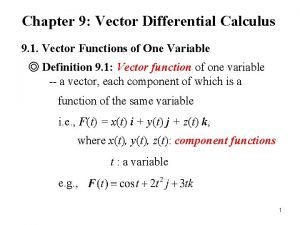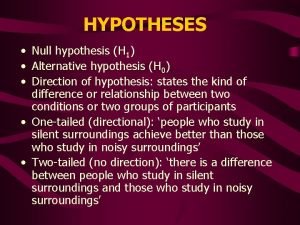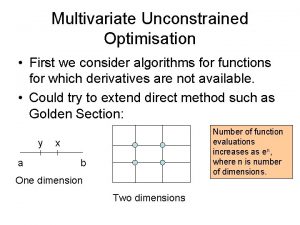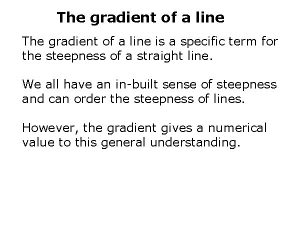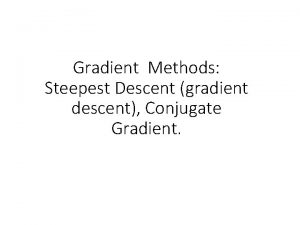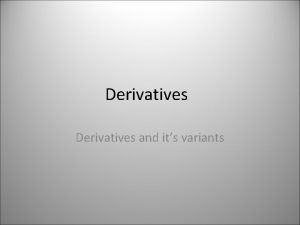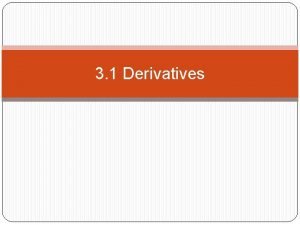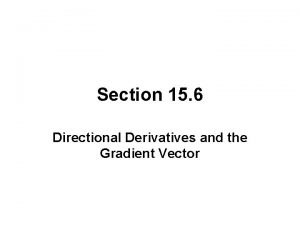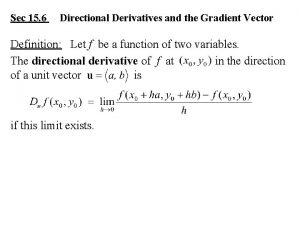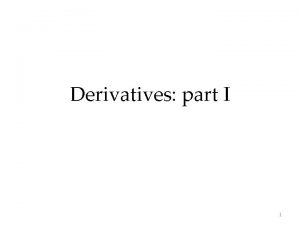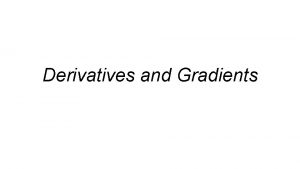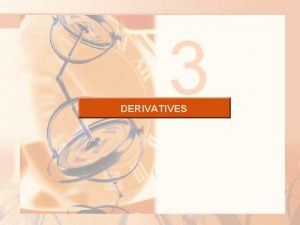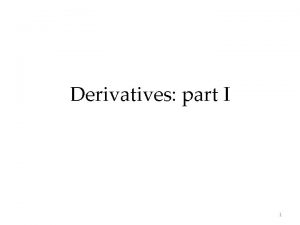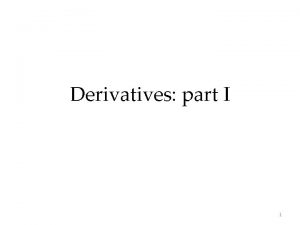14 6 Directional Derivatives Gradient Vector Directional derivative























- Slides: 23

14. 6 Directional Derivatives Gradient Vector

Directional derivative: A directional derivative is the rate of change of a function of two or more variables in any direction u, (not only in x and y). Example: Use this weather map to estimate the value of the directional derivative of the temperature function at Reno in the southeasterly direction. Answer: We start by drawing a line through Reno toward the southeast: The temperature at the point southeast of Reno is T = 60 F and the temperature at the point northwest of Reno is T = 50 F. The distance between these points looks to be about 75 miles. So the rate of change of the temperature in the southeasterly direction is: 2

Directional Derivatives Let’s define the rate of change of z at (x 0, y 0) in the direction of an arbitrary unit vector u = a, b If the unit vector u makes an angle with the positive x-axis, then we can write: z = f(x, y) u = cos , sin The vertical plane that passes through P(x 0, y 0, z 0) in the direction of u intersects S in a curve C. 3

Directional Derivative The partial derivatives fx and fy represent the rates of change of z in the x- and y-directions, that is, in the directions of the unit vectors i and j. Now: the rate of change of z = f(x, y) in the direction of u is the slope of the tangent line T to C at the point P(x, y, z): Note: • if u = i = 1, 0 , then Dif = fx • and if u = j = 0, 1 , then Djf = fy. 4

The Gradient Vector Duf (x, y) can be written as the dot product of two vectors: Duf (x, y) = fx(x, y)a + fy(x, y)b = fx(x, y), fy(x, y) a, b = fx(x, y), fy(x, y) u The first vector is called: the gradient of f. Notation: f 5

Directional Derivative = Gradient of f . Unit direction vector With this notation for the gradient vector, we can rewrite the expression for the directional derivative of a differentiable function as: This expresses the derivative in the direction of u as: the scalar projection of the gradient vector on u. If u = cos , sin this formula becomes: Du f (x, y) = fx(x, y) cos + fy(x, y) sin If u = a, b this formula becomes: Du f (x, y) = fx(x, y) a+ fy(x, y) b 6

Example 1: If f (x, y) = sin x + exy, find the gradient vector at (0, 1) then the directional derivative along the unit vector u= 3/5, 4/5 f (x, y) = fx, fy = cos x + yexy, xexy So: f (0, 1) = 2, 0 Directional derivative: Duf (0, 1)= 2, 0. 3/5, 4/5 = 6/5 7

Functions of Three Variables If f (x, y, z) is differentiable and u = a, b, c , then; Duf (x, y, z) = fx(x, y, z)a + fy(x, y, z)b + fz(x, y, z)c For a function f of three variables, the gradient vector, denoted by f or grad f, is: f (x, y, z) = fx(x, y, z), fy(x, y, z), fz(x, y, z) or, for short: Then, just as with functions of two variables, the directional derivative can be rewritten as: 8

Example 2: If f (x, y, z) = x sin yz, (a) find the gradient of f and (b) find the directional derivative of f at (1, 3, 0) in the direction of v = i + 2 j – k. Solution: (a) The gradient of f is: f (x, y, z) = fx(x, y, z), fy(x, y, z), fz(x, y, z) = sin yz, xz cos yz, xy cos yz (b) At (1, 3, 0) we have: f (1, 3, 0) = 0, 0, 3. The unit vector in the direction of v = i + 2 j – k is: 9

Example 2 – Solution cont’d Therefore: Duf (1, 3, 0) = f (1, 3, 0) u 10

Maximum Directional Derivative: = Direction of maximum change for the function! Suppose we have a function f of two or three variables and we consider all possible directional derivatives of f at a given point. These give the rates of change of f in all possible directions. Question: In which of these directions does f change fastest and what is this maximum rate of change? Answer: 11

Example 3: (a) If f (x, y) = xey, find the rate of change of f at the point P(2, 0) in the direction from P to the point Q(1/2, 2). (b) In what direction does f have the maximum rate of change? What is this maximum rate of change? Solution: (a) We first compute the gradient vector: f (x, y) = fx, fy = ey, xey f (2, 0) = 1, 2 12

Example 3 – Solution The unit vector in the direction of = – 1. 5, 2 is u = rate of change of f in the direction from P to Q is: Duf (2, 0) = f (2, 0) u cont’d so the (b) By Theorem, f increases fastest in the direction of the gradient vector f (2, 0) = 1, 2. This maximum rate of change is: | f (2, 0) | = | 1, 2 | = 13

Curves on Level Surfaces Suppose S is a level surface of a function of three variables, with equation F(x, y, z) = k, and let P(x 0, y 0, z 0) be a point on S. Let C be any curve that lies on the surface S and passes through the point P. Recall that the curve C is described by the vector function r(t) = x(t), y(t), z(t). Since C lies on S, any point (x(t), y(t), z(t)) must satisfy the equation of S, so: F(x(t), y(t), z(t)) = k 14

Tangent Planes to level Surfaces F(x(t), y(t), z(t)) = k (level surface) Use the Chain Rule to differentiate both sides of this equation: since F = Fx, Fy, Fz and r (t) = x (t), y (t), z (t) , this can be written in terms of a dot product as: F r (t) = 0 In particular, when t = t 0 we have r(t 0) = x 0, y 0, z 0 , so F(x 0, y 0, z 0) r (t 0) = 0 The gradient vector F(x 0, y 0, z 0) is perpendicular to the tangent vector r (t 0) at P! 15

Tangent Planes to level Surfaces Definition: The tangent plane to the level surface F(x, y, z) = k at P(x 0, y 0, z 0) is the plane that passes through P and has normal vector F(x 0, y 0, z 0). The equation of this tangent plane is then: 16

Normal Line to Level Surface The normal line to S at P is the line passing through P and perpendicular to the tangent plane. The direction of the normal line is therefore given by the gradient vector F(x 0, y 0, z 0) and so the symmetric equations of this normal line are: 17

Tangent Planes to Level Surfaces In the special case in which the equation of a surface S is of the form: z = f (x, y) (back to 2 variables!) we can rewrite the equation as: F(x, y, z) = f (x, y) – z = 0 (1) and considering S as a level surface of F (with k = 0). Then: (taking partial derivatives of equation (1) gives: ) Fx(x 0, y 0, z 0) = fx(x 0, y 0) Fy(x 0, y 0, z 0) = fy(x 0, y 0) Fz(x 0, y 0, z 0) = – 1 so the equation of the tangent plane becomes: fx(x 0, y 0)(x – x 0) + fy(x 0, y 0)(y – y 0) – (z – z 0) = 0 18

Example 4 Find the equations of the tangent plane and normal line at the point (– 2, 1, – 3) to the ellipsoid: Solution: The ellipsoid is the level surface (with k = 3) of the function: 19

Example 4 – Solution Therefore we have: Fx(x, y, z) = x/2 Fy(x, y, z) = 2 y Fz(x, y, z) = Fx(– 2, 1, – 3) = – 1 Fz(– 2, 1, – 3) = Fy(– 2, 1, – 3) = 2 cont’d So the equation of the tangent plane at (– 2, 1, – 3) is: – 1(x + 2) + 2(y – 1) – (z + 3) = 0 which simplifies to 3 x – 6 y + 2 z + 18 = 0. The symmetric equations of the normal line are: 20

Significance of the Gradient Vector 21

Significance of the Gradient Vector in Topology If we consider a topographical map of a hill and let f (x, y) represent the height above sea level at a point with coordinates (x, y), then a curve of steepest ascent can be drawn by making it perpendicular to all of the contour lines. 22

Summary of formulas using “del” in vector calculus: Uses of the operator “del”, : Product rule for vector calculus: 23
 Turunan vektor
Turunan vektor Divergence de gradient
Divergence de gradient Directional hypothesis example
Directional hypothesis example Directional and non directional hypothesis
Directional and non directional hypothesis Directional and non directional hypothesis
Directional and non directional hypothesis Operationalised directional hypothesis
Operationalised directional hypothesis Directional and non directional hypothesis
Directional and non directional hypothesis Hypothesis testing
Hypothesis testing 2.58 z score
2.58 z score Application of directional derivative
Application of directional derivative Gradient vector
Gradient vector Unit vector examples
Unit vector examples Coordenadas cartesianas
Coordenadas cartesianas Why is vector resolution the opposite of vector addition
Why is vector resolution the opposite of vector addition Component of a vector along another vector
Component of a vector along another vector Concentration gradient
Concentration gradient Centrifugation theory
Centrifugation theory The stage that creates an “electrochemical gradient”. *
The stage that creates an “electrochemical gradient”. * Gradient of a line
Gradient of a line Gradient undefined
Gradient undefined Tamer abu-alam
Tamer abu-alam Bloedgasanalyse
Bloedgasanalyse Concentration gradient
Concentration gradient Python boosting
Python boosting

